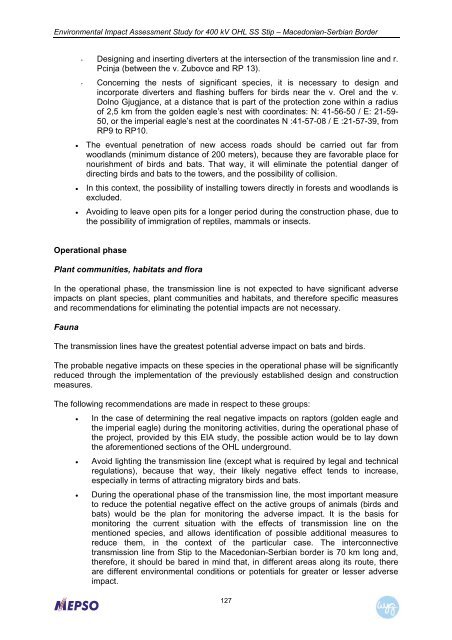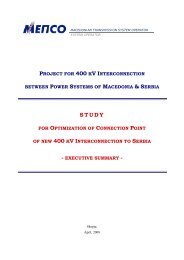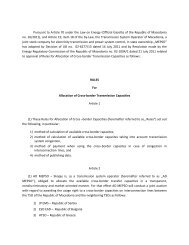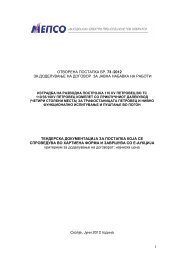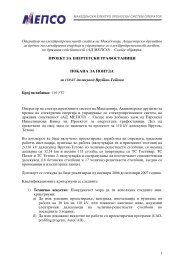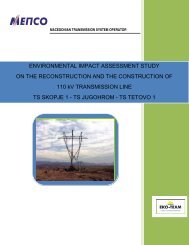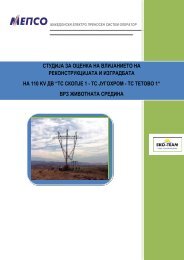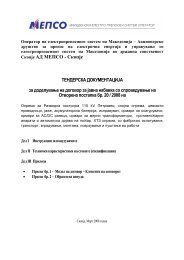Part A - EIA 400 kV OHTL Stp - мепÑо а.д.
Part A - EIA 400 kV OHTL Stp - мепÑо а.д.
Part A - EIA 400 kV OHTL Stp - мепÑо а.д.
You also want an ePaper? Increase the reach of your titles
YUMPU automatically turns print PDFs into web optimized ePapers that Google loves.
Environmental Impact Assessment Study for <strong>400</strong> <strong>kV</strong> OHL SS Stip – Macedonian-Serbian Border- Designing and inserting diverters at the intersection of the transmission line and r.Pcinja (between the v. Zubovce and RP 13).- Concerning the nests of significant species, it is necessary to design andincorporate diverters and flashing buffers for birds near the v. Orel and the v.Dolno Gjugjance, at a distance that is part of the protection zone within a radiusof 2,5 km from the golden eagle’s nest with coordinates: N: 41-56-50 / E: 21-59-50, or the imperial eagle’s nest at the coordinates N :41-57-08 / E :21-57-39, fromRP9 to RP10.• The eventual penetration of new access roads should be carried out far fromwoodlands (minimum distance of 200 meters), because they are favorable place fornourishment of birds and bats. That way, it will eliminate the potential danger ofdirecting birds and bats to the towers, and the possibility of collision.• In this context, the possibility of installing towers directly in forests and woodlands isexcluded.• Avoiding to leave open pits for a longer period during the construction phase, due tothe possibility of immigration of reptiles, mammals or insects.Operational phasePlant communities, habitats and floraIn the operational phase, the transmission line is not expected to have significant adverseimpacts on plant species, plant communities and habitats, and therefore specific measuresand recommendations for eliminating the potential impacts are not necessary.FaunaThe transmission lines have the greatest potential adverse impact on bats and birds.The probable negative impacts on these species in the operational phase will be significantlyreduced through the implementation of the previously established design and constructionmeasures.The following recommendations are made in respect to these groups:• In the case of determining the real negative impacts on raptors (golden eagle andthe imperial eagle) during the monitoring activities, during the operational phase ofthe project, provided by this <strong>EIA</strong> study, the possible action would be to lay downthe aforementioned sections of the OHL underground.• Avoid lighting the transmission line (except what is required by legal and technicalregulations), because that way, their likely negative effect tends to increase,especially in terms of attracting migratory birds and bats.• During the operational phase of the transmission line, the most important measureto reduce the potential negative effect on the active groups of animals (birds andbats) would be the plan for monitoring the adverse impact. It is the basis formonitoring the current situation with the effects of transmission line on thementioned species, and allows identification of possible additional measures toreduce them, in the context of the particular case. The interconnectivetransmission line from Stip to the Macedonian-Serbian border is 70 km long and,therefore, it should be bared in mind that, in different areas along its route, thereare different environmental conditions or potentials for greater or lesser adverseimpact.127


